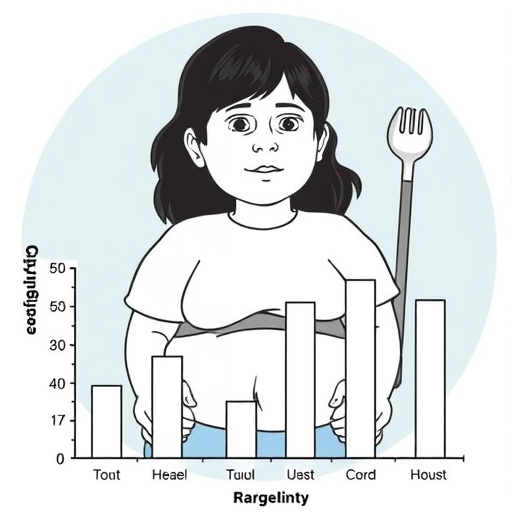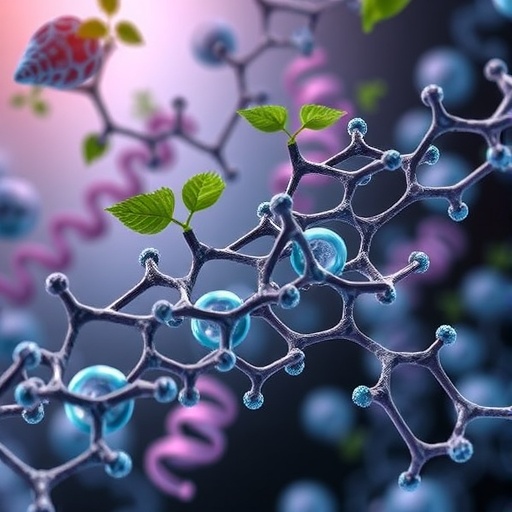In a groundbreaking case-control study published in BMC Endocrine Disorders, researchers Ustkoyuncu and Kocer explore the critical relationship between soluble receptor for advanced glycation end products (sRAGE) levels and the metabolic health of adolescents grappling with obesity, insulin resistance, and metabolic syndrome. The research addresses a pressing public health concern as childhood obesity continues to rise globally, with alarming rates of associated metabolic disorders among young people.
Advanced glycation end products (AGEs) are harmful compounds formed when proteins or fats combine with sugars in the bloodstream. The soluble receptor for advanced glycation end products (sRAGE) plays a significant role in neutralizing these AGEs, providing a protective mechanism against the chronic inflammation they can cause. The study seeks to elucidate the levels of sRAGE in adolescents who are categorized within a spectrum of metabolic dysfunction, examining the potential for sRAGE as both a biomarker and therapeutic target.
Obesity in adolescents is not just a cosmetic concern; it’s a precursor to a host of long-term health issues, including Type 2 diabetes, cardiovascular diseases, and various metabolic syndromes. In this research, Ustkoyuncu and Kocer utilized a carefully selected participant group of adolescents diagnosed with obesity and its accompanying conditions. By assessing their serum levels of sRAGE, the authors aim to correlate these levels with markers of insulin resistance and metabolic syndrome, which is characterized by a cluster of conditions—high blood pressure, elevated blood sugar, excess body fat around the waist, and abnormal cholesterol levels.
To ground the experimental design, a rich literature review provided the necessary context, revealing a range of findings that suggest the biological importance of sRAGE. Prior studies have shown a link between decreased sRAGE levels and increased AGE accumulation, leading to heightened inflammatory responses and cellular damage. By investigating this relationship specifically in adolescents, the study offers new insights that are particularly pertinent, given the age group’s unique physiological development and vulnerability to chronic diseases later in life.
The methodology ensured that the researchers could establish a robust comparison between healthy adolescents and those affected by obesity, insulin resistance, and metabolic syndrome. Rigorous criteria were applied for the inclusion and exclusion of participants, ensuring that the data collected would yield meaningful comparisons. Blood samples were analyzed to quantify sRAGE levels, and these measurements were then juxtaposed against established indices of metabolic health, such as insulin sensitivity tests and body mass index calculations.
As the data came in, the researchers uncovered intriguing results that could have far-reaching implications. Lower levels of sRAGE were observed in adolescents suffering from obesity and insulin resistance compared to their healthy counterparts. This finding resonates with the hypothesis that impaired metabolic health is linked to the body’s inability to adequately manage toxic AGEs, ultimately compromising the protective effects typically conferred by sRAGE.
The ramifications of these findings extend beyond the laboratory. Public health officials are increasingly tasked with developing comprehensive strategies to combat childhood obesity and its sequelae. If sRAGE levels can be leveraged as an early indicator of metabolic dysfunction in adolescents, it may allow for timely interventions that can redirect the course of individual health trajectories. This presents a potential pathway for not only screening but also targeted lifestyle modifications, including diet and exercise plans that can elevate sRAGE levels.
The study also underscores the importance of understanding the underlying biological mechanisms that contribute to obesity-related conditions. Chronic inflammation, driven by high AGE levels and insufficient sRAGE, provides a vital area for further investigation. Future studies may build upon these findings by examining potential therapeutic agents that can elevate sRAGE levels, thus offering a dual benefit—improving insulin sensitivity while simultaneously mitigating the risks associated with high AGE accumulation.
In addition to the immediate health implications, the research offers insights into the societal and economic burdens of metabolic syndrome among adolescents. With healthcare costs skyrocketing due to chronic diseases stemming from obesity, early identification through biomarkers such as sRAGE could represent not just a win for affected individuals but also for the broader healthcare system.
As the global community navigates the intricacies of an obesity epidemic, this study stands as a beacon of hope. By investigating the intersection of obesity, insulin resistance, and inflammatory responses in adolescents, Ustkoyuncu and Kocer have contributed invaluable data that could influence future public health policies, clinical practices, and research directions.
The study is a call to action for researchers, healthcare providers, and policymakers alike. By prioritizing adolescent health and focusing on innovative biomarkers, we can pave the way for a healthier future generation. Groundbreaking discoveries such as these can reshape our understanding of childhood obesity, its neurological impacts, and the broader implications for society as a whole.
In conclusion, Ustkoyuncu and Kocer’s work significantly enhances our understanding of how sRAGE operates within the dynamic landscape of adolescent metabolic health. Given the rising prevalence of obesity globally, research like this is not only timely but essential in the ongoing effort to combat this epidemic effectively.
Subject of Research: Levels of soluble receptor for advanced glycation end products (sRAGE) in adolescents with obesity, insulin resistance, and metabolic syndrome.
Article Title: Soluble receptor for advanced glycation end product (sRAGE) levels in adolescents with obesity, insulin resistance and metabolic syndrome: A case-control study and the review of the literature.
Article References:
Ustkoyuncu, P.S., Kocer, D. Soluble receptor for advanced glycation end product (sRAGE) levels in adolescents with obesity, insulin resistance and metabolic syndrome: A case-control study and the review of the literature. BMC Endocr Disord 25, 209 (2025). https://doi.org/10.1186/s12902-025-02025-9
Image Credits: AI Generated
DOI: 10.1186/s12902-025-02025-9
Keywords: sRAGE, obesity, insulin resistance, metabolic syndrome, adolescents, advanced glycation end products, inflammation, biomarkers, public health.
Tags: adolescent health and metabolic disordersadvanced glycation end productsbiomarkers for metabolic healthcardiovascular disease in youthcase-control study on sRAGEchronic inflammation in obesityinsulin resistance in teenagersobesity and metabolic syndromepublic health concerns childhood obesitysRAGE levels in adolescentstherapeutic targets for obesitytype 2 diabetes risk factors





